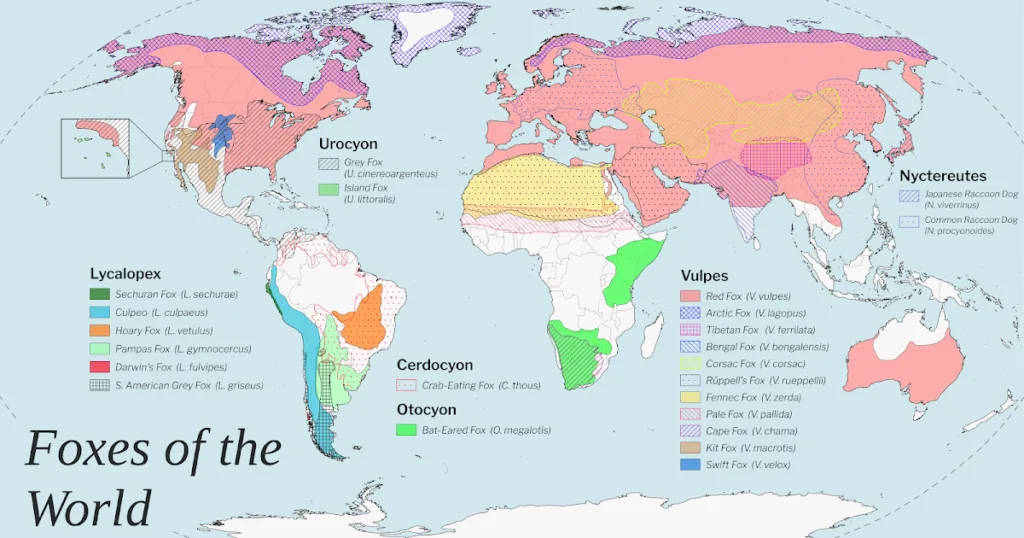Characteristics of the Tibetan Fox
The Tibetan fox (Vulpes ferrilata) is a remarkable species, well-adapted to the rugged and extreme environment of the high Tibetan plateau. This animal typically measures between 18 to 24 inches in length, with an additional tail length of about 12 to 16 inches. Weighing between 5 to 10 pounds, the Tibetan fox is a medium-sized member of the true fox family. Its dimensions contribute not only to its agility but also to its survival skills in harsh climates.
The coat of the Tibetan fox is another distinctive characteristic. Its fur is typically a mix of gray, brown, and black shades, providing camouflage against the arid terrain and rocky outcrops of its habitat. The underbelly is usually lighter, often cream or white, which helps the fox blend seamlessly into the snow and gravel of the plateau. Additionally, the Tibetan fox possesses a thick and fluffy tail, which can be used for balance while maneuvering through its mountainous environment. This adaptation aids in maintaining stability while hunting or navigating steep slopes.
One of the most fascinating features of the Tibetan fox is its facial structure. The fox has a somewhat elongated face, with slanted, narrow eyes that grant it a keen sense of sight, crucial for spotting potential prey from great distances. Its ears are also relatively large, enhancing its hearing capabilities. These adaptations are vital for locating food, as the Tibetan fox primarily preys on small mammals, birds, and even insects.
Moreover, the Tibetan fox exhibits unique behavioral traits that are evolutionary responses to its environment. It has developed a certain level of social structure, often being spotted in pairs or small family groups, which facilitates cooperative hunting. Overall, the Tibetan fox is an intriguing representation of evolutionary success in one of the world’s most challenging habitats.

Habitat of the Tibetan Fox
The Tibetan fox (Vulpes ferrilata) is predominantly found in the high-altitude ecosystems of the Tibetan Plateau and its surrounding regions, characterized by a unique combination of geographical features and climatic conditions. This vast area extends over 2.5 million square kilometers and is known for its extreme altitude, often exceeding 4,000 meters above sea level. The rugged terrain consists of expansive grasslands, alpine meadows, and some rocky outcrops, providing a range of habitats suitable for the Tibetan fox.
The climate of the Tibetan Plateau is highly variable, marked by cold winters and relatively mild summers. Average temperatures can dip drastically, particularly during winter months, with recorded lows approaching -40 degrees Celsius. Despite these harsh conditions, the Tibetan fox has adapted to thrive in this environment. Its thick, dense fur acts as insulation against the biting cold, while its agile physique allows it to navigate the often challenging terrain in search of food.
Altitude plays a significant role in shaping the Tibetan fox’s habitat. The high elevation affects not only the temperature but also the availability of prey species. The fox primarily preys on small mammals such as pikas and rodents, which are prevalent in the rocky and grassy areas of the plateau. The seasonal changes also impact the population dynamics of these prey animals, thereby influencing the Tibetan fox’s hunting patterns and distribution across the landscape. During the warmer months, the fox may venture into lower altitudes in search of more abundant food sources, whereas, in winter, it tends to remain higher up, where it protects its territory. Through its adaptations to the unique challenges posed by its habitat, the Tibetan fox remains a key player in the ecosystem of the Tibetan Plateau.

Behavior and Adaptations
The Tibetan fox, recognized for its distinctive appearance and adaptability, exhibits a range of behaviors suited to the harsh environment of the high Tibetan Plateau. Socially, these foxes tend to be solitary, although they may occasionally be spotted in pairs or small family groups during the mating season. This solitary nature helps them efficiently navigate their expansive territories, which can span several square kilometers in search of food.
Hunting techniques of the Tibetan fox are finely tuned to the challenges posed by their environment. They primarily rely on a diet that consists of small mammals, such as pikas and rodents, as well as birds and insects. A notable behavior observed is their impressive ability to locate prey hidden beneath snow or dry grass. The Tibetan fox employs a unique hunting strategy known as “mousing,” where it uses its keen sense of hearing to detect sounds of burrowing animals, followed by a spectacular leap into the air, allowing it to plunge into snow and vegetation to unearth its meal.
In terms of adaptations, Tibetan foxes have developed a thick fur coat that aids in insulation against low temperatures that can reach extreme lows on the plateau. Their physiological attributes include a compact body and thick fur that minimizes heat loss, making them resilient to the biting cold. The scarcity of food prompted by the plateau’s sparse vegetation has also led them to be opportunistic feeders, showcasing flexibility in dietary choices based on availability.
Reproductive behavior in Tibetan foxes typically involves a monogamous pairing system. During the breeding season, a male may exhibit courtship displays, which include vocalizations and scent marking. The gestation period lasts around two months, and females give birth to a litter of typically four to six kits, which will be nurtured until they are ready to fend for themselves. This complex suite of behaviors and adaptations enables the Tibetan fox to thrive in an environment that would otherwise pose significant challenges for survival.

Conservation Status and Threats
The Tibetan fox (Vulpes ferrilata), an emblematic species of the Tibetan plateau, is currently facing significant challenges that threaten its survival. Habitat loss has emerged as one of the foremost issues impacting this unique resident, primarily driven by expanding agricultural activities and infrastructure development. As human populations grow within this fragile ecosystem, the natural habitats of the Tibetan fox are increasingly fragmented, resulting in reduced access to essential resources such as prey and shelter.
In addition to habitat degradation, climate change poses a considerable threat to the Tibetan fox. Rising temperatures and altered precipitation patterns can disrupt the delicate ecological balance of the plateau, affecting faunal and floral communities upon which the fox relies. These environmental shifts can lead to resource scarcity, further jeopardizing the species’ survival. Moreover, the increased frequency of extreme weather events associated with climate change may also pose direct risks, such as habitat destruction and food shortages.
Human encroachment into the Tibetan plateau exacerbates these threats, with poaching and illegal wildlife trade posing additional risks to the Tibetan fox. As more humans inhabit the area, conflicts between livestock and wildlife can intensify, leading to retaliatory killings of foxes and other predators. Additionally, the introduction of domestic animals may contribute to disease transmission, further endangering the health of wild populations.
Despite these challenges, several conservation efforts are underway to protect the Tibetan fox and its habitat. Conservation organizations are working in partnership with local communities to promote sustainable land-use practices and to advocate for the establishment of protected areas. The preservation of this unique species is essential not only for maintaining biodiversity on the Tibetan plateau but also for ensuring a healthy ecosystem that supports various other species. Implementing holistic conservation strategies will ultimately be pivotal in securing the future of the Tibetan fox and its high-altitude home.





